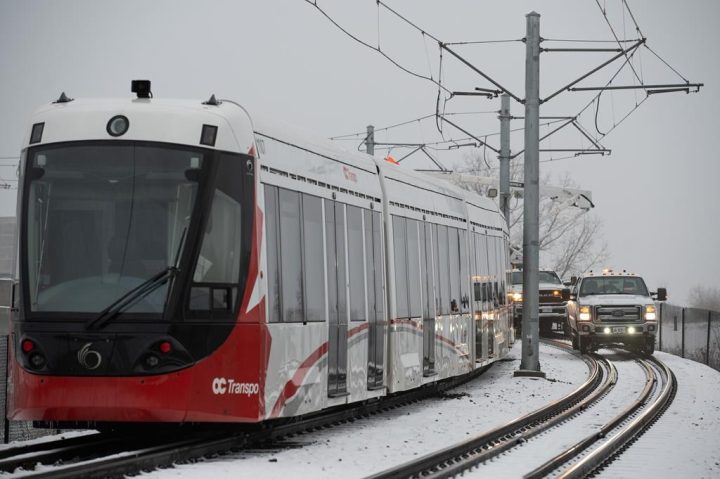Ottawa city staff are looking at long-term solutions to handle freezing rain after the light rail transit system was partly closed for six days at the beginning of January due to massive ice buildup.

An ice storm on the evening of Jan. 4 damaged the system’s overhead lines, and witnesses saw sparks flying from the roof of a train.
“The contact wires basically melted,” said Richard Holder, the city’s director of engineering services.
Several trains got stuck.
Holder explained that paired with high humidity, the ice led to a significant electric current on the trains’ pantographs _ apparatuses located on the roofs of trains that collect energy from the lines that power them.
He told the city’s transit commission on Thursday that the system reached the limit of the amount of freezing rain it could handle. He said workers had to break the ice off by hand over about 5.6 kilometres of the overhead wire system.
“When I say by hand, it is literally somebody in a vehicle on a bucket breaking the ice off by hand,” said Holder.
Matti Siemiatycki, a professor at the University of Toronto and the director of its infrastructure institute, said that it shouldn’t have come as a surprise that Canada experiences winter _ and with it, a variety of different weather situations.
- Life in the forest: How Stanley Park’s longest resident survived a changing landscape
- Bird flu risk to humans an ‘enormous concern,’ WHO says. Here’s what to know
- More youth are seeking EI amid rising unemployment rates: StatCan
- Mental health support still lacking 4 years after mass shooting: Nova Scotia mayor
He said the recent incident highlighted the need for preparedness regardless of weather conditions.
Siemiatycki said the Toronto Transit Commission has a vehicle that travels up and down the streets spraying de-icer on top of the wires to prevent damaging ice buildup.
“When you run a system that is the backbone of a transportation network, it’s incumbent that you’re looking at all of the range of risks, and then being proactive in terms of the steps within reason that can be taken,” he said.
“And there are going to be extreme weather cases.”
At Thursday’s meeting, city staff outlined both short- and long-term plans to address future delays that might be caused by freezing rain, including using anti-freeze and heating the cables at certain areas that need it most.
There is also discussion of procuring a non-electric recovery vehicle for future situations when trains don’t have power. It would run on diesel, similar to equipment used for heavy rail, and staff could use it to recover stuck trains during electrical outages.
Transit commission chair Coun. Glen Gower said the cost of procuring additional devices is not something the city will have to foot.
He said the Rideau Transit Group would be required to pay for the improvements under their 30-year maintenance agreement with the city, which requires them to maintain good service.
Coun. Riley Brockington asked about the construction of the next phase of the light rail system, and how staff will avoid mistakes that happened during the first stage.
He noted that freezing rain will continue to be an issue in Ottawa.
“We want to make sure that the system runs smoothly in all types of storms,” said Brockington.
“So the intent would be to make sure that system that we have can withstand and sustain those those types of weather events.”
Holder said officials are looking to procure extra devices called winter carbons, which are installed onto the pantographs and can break through and sheer off ice more effectively.



Comments